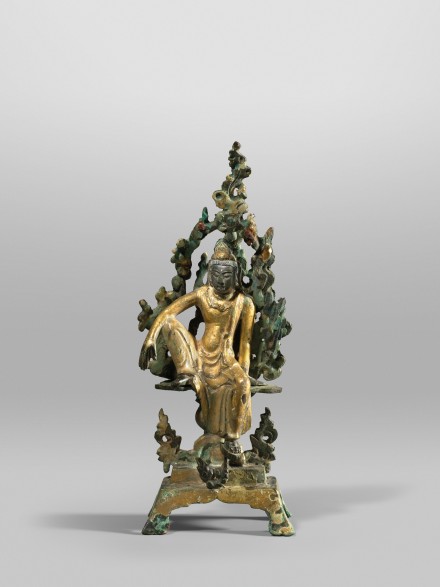J.J. Lally & Co., Oriental Art / New York City, New York
MenuPast Exhibition
Buddhist Sculpture from Ancient China
March 10-31, 2017

19.
A GILT BRONZE FIGURE OF SOUTH SEA GUANYIN
Song Dynasty (960 - 1279)
the compassionate bodhisattva shown wearing long robes and a simple crown, seated in a languid posture of royal ease with one foot resting on a lotus pod at the front of the stepped dais, within a stylized grotto of pierced rockwork rising in rippling pointed layers, the figure and shrine covered with thick gilding over gesso, the black patinated metal showing through in several places including the face with small features well cast in a benevolent gaze.
Height 8 5⁄8 inches (22 cm)
A similarly modelled gilt bronze figure of Guanyin on a stepped four-legged dais in the collection of the Freer Gallery of Art in Washington D.C. is illustrated by Munsterberg, Chinese Buddhist Bronzes, Tokyo, 1967, pl. 69.
Another bronze figure of Guanyin in the same pose but lacking both the rockwork back and the dais is illustrated in Gugong bowuyuan lidai yishuguan chenliepin tumu (Illustrated Catalogue of the Art Displayed at the Palace Museum), Beijing, 1991, p. 293, fig. 805. The same figure is also illustrated in Wenwu cangpin dingji biaozhun tuli: zaoxiang juan (Illustrated Important Chinese Cultural Relics Ranking Standard: Religious Sculptures), Beijing, 2011, p. 220, no. 170.
The stylized rockwork grotto and the posture of royal ease are associated with the avatar of Guanyin known as the South Sea (Nanhai) Guanyin, also referred to as the Water-Moon (Shuiyue) Guanyin. The cult of the South Sea or Water-Moon Guanyin arose in China in the Tang dynasty and became widely popular in paintings, literature and sculpture during the Song dynasty. Mount Potalaka, Guanyin’s mountain home described in the Avatamsaka sutra, became identified in China with Mount Putuo, on a small island at the mouth of Hangzhou Bay, near Ningbo, Zhejiang province. Mount Putuo is known as one of the Four Sacred Mountains of Buddhism.
宋 鎏金銅南海觀音像 高 22 厘米
19.
A GILT BRONZE FIGURE OF SOUTH SEA GUANYIN
Song Dynasty (960 - 1279)
Height 8 5⁄8 inches (22 cm)